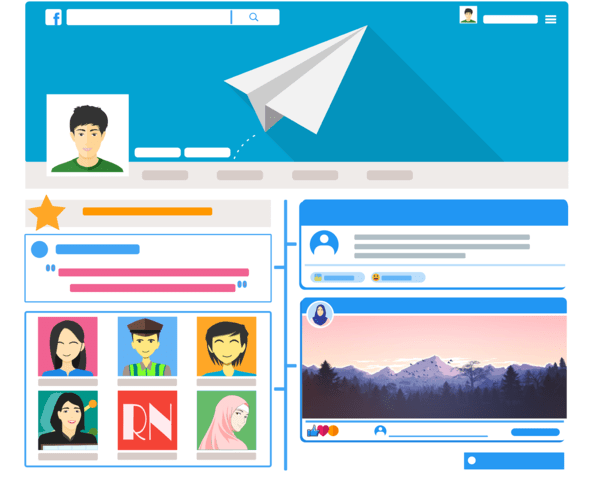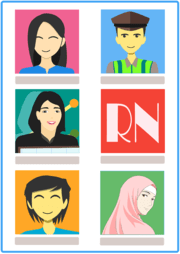How to Help a Child Set up an Online Profile Safely
Social media and online platforms are used by people all over the world with a wide range of different ages. As technology becomes more and more integrated into our lives, children and young people are using the internet and social media for all kinds of things, often from an early age.
Monitoring your child’s internet use is very important, but you shouldn’t necessarily stop them from setting up online accounts for social media platforms or websites for things like gaming. Instead, the best thing you can do is set up profiles with your child so that you feel confident that they’re staying safe.
In this article, we explain some of the risks that online profiles pose, and then share the best advice for avoiding these by setting up a safe profile for your child. We also cover how to talk to your child about online safety, which is an important conversation to have before you let them start using the internet.
The Risks of Online Profiles
There are plenty of positives to using the internet and it can be a fantastic place for children and young people to learn, play games, connect with friends and find communities or groups they feel a part of. However, there are a range of risks that come from setting up an online profile, and it’s important to understand these and share them with your child before you create anything online.
Some of the main risks of having online profiles include:
- Cyberbullying
- Privacy invasion
- Identity theft
- Exposure to offence or upsetting content
- Grooming
- Phishing
These risks have consequences that range from causing your child distress to putting them in serious danger from predatory adults. You should make sure that you explain these risks to them before you set up the profile, ensuring that they know the warning signs to look out for and understand why internet safety is so important. Online short safeguarding courses can be a useful resource in educating yourself on online safeguarding risks.
Top Tips for Setting Up a Safe Online Profile
Let your child know that one of the best ways to stay safe online is by setting up a safe online profile. Depending on their age, you can either ask them to follow the below advice or set up the profile with them and go through the following steps.
Choose a Secure Password
One of the most important things to teach about online safety for kids is the importance of choosing a secure password. This reduces the chance that their online account might be hacked and is a good introduction to personal security for online accounts.
Different websites or apps might have different criteria for what constitutes a ‘secure’ password, which may impact your choices. In general, it’s recommended that you get your child to use a mixture of letters, numbers, symbols and cases in their password to make it as unique as possible.
To help your child remember their password, encourage them to pick a memorable word, such as their favourite animal or a character from a book or television show. If you think they need help remembering it around, get them to write it down somewhere, disguised as something else.
Pick a Safe Username
Usernames are used on a range of online platforms to identify different profiles and often include the user’s real name. To protect your child’s identity and keep them safe, you should encourage them to choose a username that doesn’t include their name or any other personal information that could be used to identify or find them in real life.
Your child can still choose a username that feels personal by picking words that link to their favourite hobbies, colour, or animals or use a nickname. It’s also important to let them know never to share their real name with someone over the internet, unless they are sure that they’ve met them in real life already.
Limit Personal Information
On social media websites like Instagram and Facebook, setting up a profile and sharing content involves sharing more personal information in the form of photos and posts. With photos in particular, you should advise your child to avoid any images of themself that link them to a particular location or group, such as in their school uniform, in a sports club uniform, or outside of your house. These images could be used by predators to find your child in real life.
You should also supervise your child whilst they’re writing a bio for their online profile, if it’s required. Again, advise them to avoid any personal details, such as their full name, age, their school and where they live.
Use a Family Email Address
If your child is still in primary school, a good idea is to set up a family email address and get them to use this to sign up for online accounts. You can set up the preferences on this account so that emails get sent every time there’s a notification, which allows you to keep an eye on their activity without having full access to their profile.
This can also be very useful if your child creates a profile on a gaming app or website where additional purchases can be made. Using a family email, and setting up email alerts to approve a purchase, will stop your child from buying anything you don’t approve of.
Check Additional Features
Some online platforms, apps and even devices have special features that are designed to give parents some control or insight into what their child is using them for. This is particularly useful for younger children that are less aware of the risks of using the internet, such as personal data privacy and the kind of content they might come across.
When setting up a profile with your child, you might be able to select options or restrict their account in a way that means they can’t connect with strangers’ accounts, can’t spend any money, or can’t receive messages. Some apps might have a kid-friendly version or give you the option to restrict any mature content that might be shown to your child whilst they’re using it.
Set Up Your Own Profile

When your children want to start using social media, a good way to give them independence whilst keeping an eye on their activity is to set up your own profile on the same site and connect with them so that you can see what they’re posting. You won’t be able to control what they post and interact with on these platforms, but you will be able to see it and can advise them on what they’re sharing.
Install Parental Controls
Finally, it’s worth investigating the different parental controls that you can install on apps, devices and even the broadband router for your house. These controls allow you to limit what your child will be able to do on their devices or on certain websites, which is very useful when they’re younger and you want to ensure they have a positive experience whilst online.
How to Talk to Your Child About Online Safety
When you’re helping a child to set up an online profile, it’s important to talk to them about online safety and the risks that using apps and websites might have. The most important thing to remember is to be honest but avoid sharing anything that might scare your child, as you want them to be able to enjoy all the benefits of being online.
Outline the potential risks of having an online profile that we shared at the start of this article. Explain that these things are unlikely to happen, but that they are something that your child should be aware of.
Next, explain what some of the warning signs of bad behaviour on the internet are. This will help your child to spot suspicious messages, potentially upsetting content or bullying behaviour when it starts, which hopefully means they’ll be able to remove themselves from potentially harmful situations or ask for help immediately.
The most important thing to share when you’re giving your child tips for staying safe online is that they should always talk to a trusted adult if they see or receive something that makes them feel sad, uncomfortable or unsure. Let them know that they can talk to you, another family member or someone at school about anything they experience online, and that they won’t get into trouble for sharing.
Summary
Technology is developing at ever-increasing rates, and more and more children are using it at younger and younger ages. Digital literacy and the ability to connect with others online are very important when children are growing up, so the best thing you can do is equip your child with the information they need to use the internet safely, with an online profile that doesn’t put them at risk.




